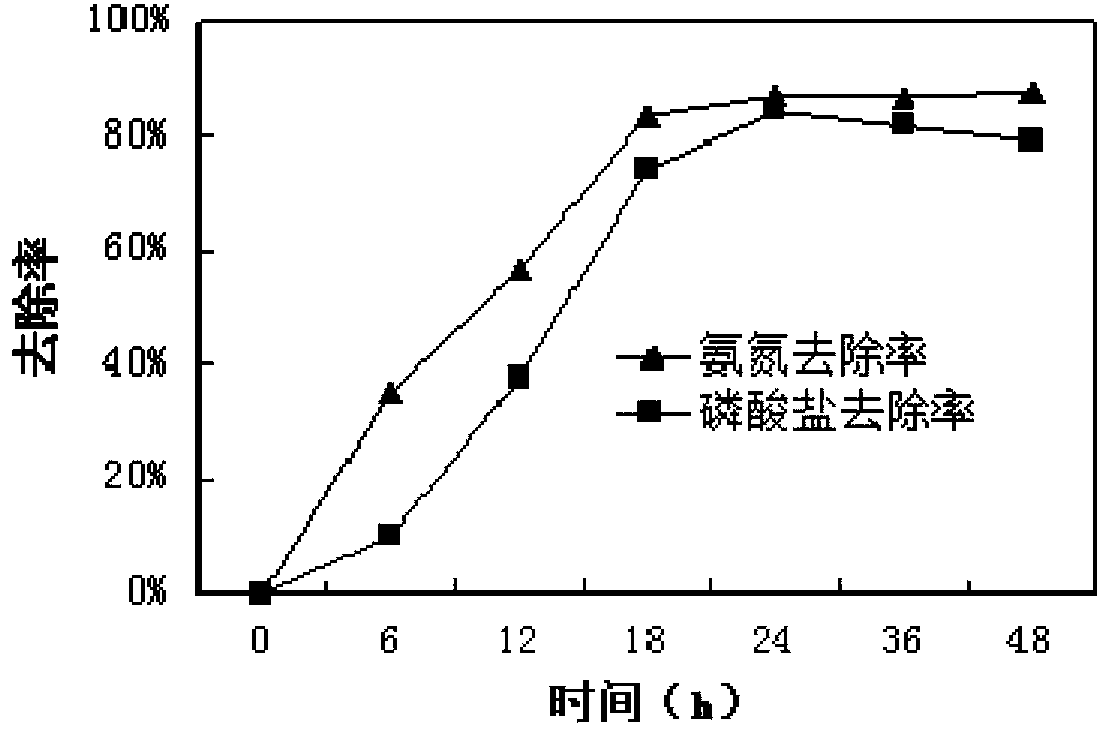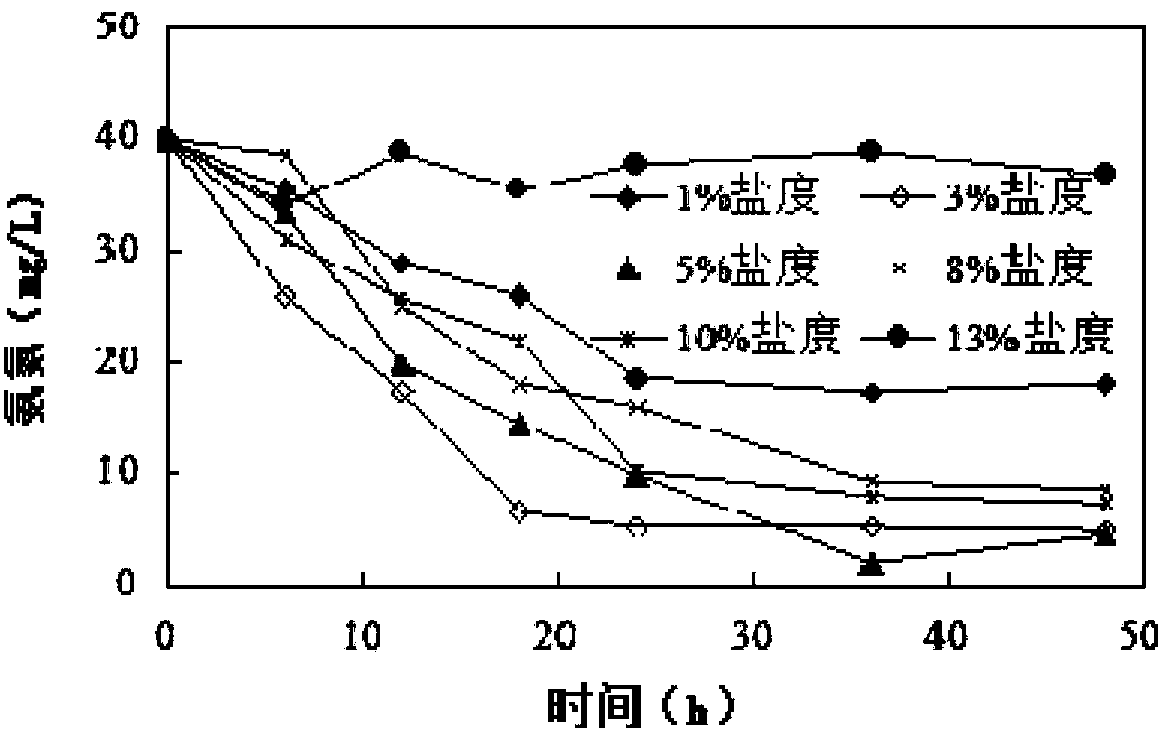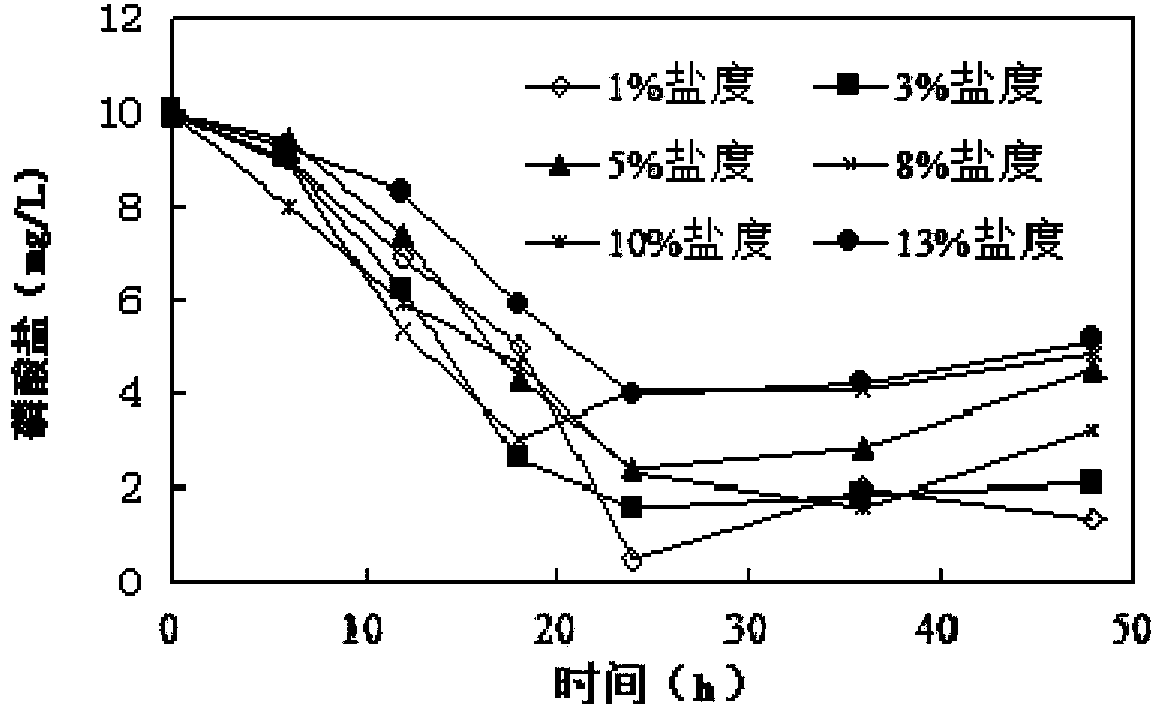High-salt heterotrophic nitrification-aerobic denitrification dephosphorization brachybacterium and application of brachybacterium in wastewater treatment
An aerobic denitrification and Brevibacterium microbacteria technology, which is applied in aerobic process treatment, biological water/sewage treatment, water/sludge/sewage treatment, etc. Effect
- Summary
- Abstract
- Description
- Claims
- Application Information
AI Technical Summary
Problems solved by technology
Method used
Image
Examples
Embodiment 1
[0038] Implementation Example 1: Simultaneous Denitrification and Phosphorus Ability Determination of Brachybacterium at a Salinity of 3%
[0039] Inoculate the Brachybacterium strain (the same below) preserved in the General Microbiology Center of the China Microbiological Culture Collection Management Committee (CGMCC for short) with the preservation number CGMCC No. Invade and maintain the growth vitality of the bacteria, and carry out enrichment culture. The cultured bacterial solution was centrifuged, washed three times with sterile water, and the optical density (OD 600 ) for the bacterial suspension of 1-2.
[0040] Take 10mL of the above bacterial suspension and add two test media containing 90mL of 3% salinity (calculated as NaCl) (0.94g glucose, 0.153g NH 4 Cl, 0.035g KH 2 PO 4 , 0.1gMgSO 4 ·7H 2 O, 0.006g FeSO 4 ·7H 2 O, pH 7.0~7.5) Erlenmeyer flasks, sealed with 9 layers of gauze, and cultured in a shaker at 30°C and 150rpm. The culture medium that was not...
Embodiment 2
[0042] Implementation Example 2: Denitrification and phosphorus removal effects of strains under different salinity conditions
[0043] Using glucose as the carbon source and ammonia nitrogen as the nitrogen source, the Brachybacterium strains described in the examples were tested for their ability to remove ammonia nitrogen at different salinities. The specific implementation steps are as follows:
[0044] Inoculate the Brachybacterium strain into 100ml inorganic salt medium (0.94g glucose, 0.153g NH 4 Cl, 0.035g KH 2 PO 4 , 0.1gMgSO 4 ·7H 2 O, 0.006g FeSO 4 ·7H 2 O, 30g-150g NaCl, pH7.0~7.5), pre-cultivate in a shaker at 30°C and 150rpm. When the strain grows to the late logarithmic growth phase, take 10ml of the bacterial solution and insert it into 90ml of fresh inorganic salts with a salinity (calculated as NaCl) of 1%, 3%, 5%, 8%, 10% and 13% for culture Culture medium was shaken at 30°C and 150 rpm in a shaker. The culture medium that was not inoculated with th...
Embodiment 3
[0047] Implementation example 3: Denitrification and phosphorus removal experiments of bacterial strains under different pH conditions
[0048] The Brachybacterium strain was inoculated in 100 ml of a 3% inorganic salt medium (as in Example 2) with a salinity (calculated as NaCl), and pre-cultured in a shaker at 30° C. and 150 rpm. When the strain grows to the late logarithmic phase, take 10ml of the bacterial liquid and put it into 90ml of fresh inorganic salt medium, adjust the pH of the medium to 6.5-7.0, 7.0-7.5 and 7.5-8.0 respectively, at 30°C Shaking culture was carried out in a shaker at 150 rpm. The culture medium that was not inoculated with the bacterial suspension was used as a blank control for experiments under the same conditions. Take a small amount of reaction solution at 6h, 12h, 18h, 24h, 36h and 48h, a part of which is directly used to measure the optical density of the bacteria, and the rest is centrifuged at 8000rpm for 10min, and the supernatant is take...
PUM
 Login to View More
Login to View More Abstract
Description
Claims
Application Information
 Login to View More
Login to View More - R&D
- Intellectual Property
- Life Sciences
- Materials
- Tech Scout
- Unparalleled Data Quality
- Higher Quality Content
- 60% Fewer Hallucinations
Browse by: Latest US Patents, China's latest patents, Technical Efficacy Thesaurus, Application Domain, Technology Topic, Popular Technical Reports.
© 2025 PatSnap. All rights reserved.Legal|Privacy policy|Modern Slavery Act Transparency Statement|Sitemap|About US| Contact US: help@patsnap.com



